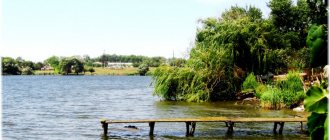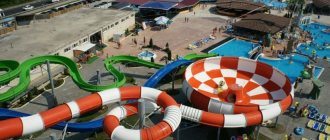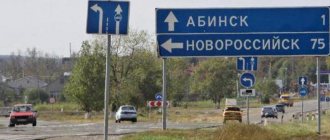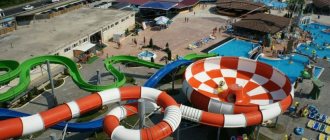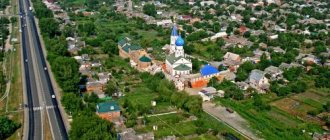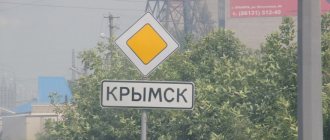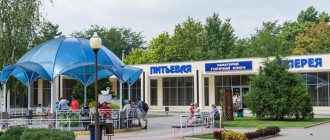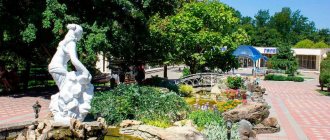Monument to the founders of Novorossiysk
Monument to the founders of Novorossiysk
Novorossiysk
The most famous monument in Novorossiysk is dedicated to the founders of the city. It is located on the shore of Tsemes Bay, on the Admiral Serebryakov embankment.
It was here that General Nikolai Raevsky and Vice Admiral Mikhail Lazarev landed in 1834. A few years earlier, the Turkish Tsemes Bay came into the possession of Russia, and the military leaders had to build a fort on the ruins of an old enemy fortress. The history of Novorossiysk began with him. And Rear Admiral Lazar Serebryakov in 1841 began to transform the military camp into a city. A school, a hospital and even a library appeared here.
The monument to the founders of the city was created by local sculptor Alexander Suvorov. Bronze figures of Raevsky, Lazarev and Serebryakov are installed on a granite pedestal. On the sides of the monument there are bronze plates with historical dates and cannons created according to models of the 19th century. The monument contains statements from Emperor Nicholas I and the hero of the War of 1812, Field Marshal Mikhail Vorontsov, the year the city was founded and the names of its founders.
Tips for staying in the city
Tourists in Novorossiysk should take into account the following nuances:
- during the season, life at a resort is more expensive (everything becomes more expensive - from housing to food);
- There are three souvenirs that are considered traditional in Novorossiysk - wine, Abrau-Durso champagne, and Krasnodar tea from local plantations (Dagomys or Adler factories).
Krasnodar tea has a unique taste and aroma
Video: getting to know the city of Novorossiysk
httpv://www.youtube.com/watch?v=embed/jcf6ftC_ngs
Ship of military glory "Mikhail Kutuzov"
Ship of military glory "Mikhail Kutuzov"
Novorossiysk
On the Admiral Serebryakov embankment you can also see the museum ship - the cruiser Mikhail Kutuzov. It was laid down in February 1951 at the Nikolaev Shipyard, and three years later it was launched.
"Mikhail Kutuzov" was part of the Black Sea Fleet. He served in the Mediterranean and Black Seas, in the central Atlantic, and also participated in two armed conflicts of the Arab-Israeli War - in 1967 and 1973. During all this time, the ship traveled 211,900 miles - that’s almost 400 thousand kilometers.
The ship left service in 1998, and in 2012, the ship of military glory “Mikhail Kutuzov” became a branch of the Central Naval Museum. Tours take place on the upper deck. Museum guests can see the ship's bell, cannons and mine armament of the ship. Also open to visitors are the ship's wardroom, the galley - the ship's kitchen, the first aid station, one of the combat posts and the sailor's quarters.
History and description
Today, millions of our compatriots believe that Brezhnev was a bright personality thanks to his funny speech articulation, eyebrows, a “ton” of orders and the habit of kissing the secretaries general of the states of the socialist bloc on the lips. However, a large percentage of Russians know the leader of 1964-1982. on a completely different side. He was a fearless commander of a tank company, the “father” of one of the partisan formations, and an experienced and brave hunter. When he was the first secretary of the Communist Party of Moldova, he later became a fan of high speeds. Having the largest vehicle fleet in the USSR, Brezhnev personally tested dozens of new products from our automobile industry.
Having received an identical position in Kazakhstan, it was he who came up with the idea of turning half of the territory of this republic into fertile fields. Moreover, he stood at the origins of the great space future of the Soviet Union - the construction of Baikonur.
As a result, a monument to the hero, better known as “dear and beloved Leonid Ilyich,” was to appear in one of the central city squares. Moreover, during the Second World War, at one stage he was the organizer of its defense from the Nazi occupiers. Let us also emphasize that Novorossiysk enjoyed the expressed favor of the first secretary. The opening took place in 2004 - with the participation of the people who most contributed to the emergence of the new attraction (mayor V. Sinyagovsky and businessman-philanthropist D. Shilov). The author of the composition was the brilliant creative figure Nikolai Bugaev. However, in 2012, the mini-ensemble was moved to its current location.
Novorossiysk Historical Museum-Reserve
Novorossiysk Historical Museum-Reserve
Novorossiysk
The Novorossiysk Historical Museum-Reserve is the oldest in the city; it was created in 1916 as a museum of nature and history of the Black Sea coast of the Caucasus. However, during the Great Patriotic War, he lost almost all of the exhibits. A new exhibition with a diorama triptych “Liberation of Novorossiysk from the Nazi invaders. 1943" was created only in 1960.
The museum-reserve houses archaeological finds from ancient settlements and burial grounds, a collection of anchors, the family fund of the writer Fyodor Gladkov and the photo archive of TASS correspondent Evgeniy Khaldei.
The complex includes permanent exhibitions that tell about the history and nature of the region, and the house-museum of the Soviet writer Nikolai Ostrovsky: the building and interiors were restored using old documents and photographs. The Historical Museum-Reserve also owns an exhibition hall and the “Malaya Zemlya” memorial.
What to see in Novorossiysk depending on the time of year
If you go to the city during the holiday season, which begins in June and lasts until September, then, of course, you should definitely visit the beaches in Aleksino and Myskhako. The evening can be spent sightseeing. However, prices for tickets to the city are higher during these months and it can be difficult to get them. The same applies to housing: rented rooms become almost one and a half times more expensive.
But if the trip is for informational purposes and the issue of swimming in the sea is not fundamental, the weather in the city, protected by mountains, is conducive to tourist walks at any time of the year.
In winter, the city takes on a fabulous look: snow-covered streets and calm seas
Memorial "Malaya Zemlya"
Memorial "Malaya Zemlya"
Novorossiysk
The “Malaya Zemlya” memorial is located in the area of Cape Myskhako, seven kilometers from Novorossiysk. It consists of a museum of military glory and a museum of military equipment. “Malaya Zemlya” was erected in memory of Soviet soldiers who fought for the city during the Great Patriotic War.
On the night of February 4, 1943, paratroopers led by Major Caesar Kunikov broke through enemy fire, landed on the shore and captured a bridgehead, called “Malaya Zemlya.” Its defense lasted 225 days. From here began the key assault on the positions of the Nazi invaders, thanks to which Novorossiysk was liberated.
The monument was created by Soviet architects Vladimir Khavin, Yakov Belopolsky, Roman Kananin and sculptor Vladimir Tsigal. It was installed on the shore of Tsemes Bay made of granite and bronze. The memorial resembles the bow of a landing ship that rushed ashore. The bas-relief on the right side depicts the faces of soldiers ready to run into the attack; on the left is a sculpture of a sailor, an infantryman, a commander and a female medical instructor, as if frozen a second before the battle.
Around the monument you can still see traces of battles: grass-covered trenches, ditches and trenches. Nearby there is a museum of military equipment and weapons from the Great Patriotic War and a stele with a commemorative inscription. Inside the monument there is a gallery of military glory with a bronze capsule “Heart”. Around it are the names of the soldiers and sailors who fought on the Malaya Zemlya bridgehead.
Monument "Line of Defense"
We are talking about the main brand of the Eastern Municipal District. It is located right on the Sukhumi highway (M-4 highway) - on the site adjacent to the cement entrance. Nearby are the “Shooted Car” and the “Destroyed Cement Workers’ Palace of Culture”. Get off at bus stop No. 11 and No. 646 "October".
“Rubezh” was built in 1978. The 40 m long stele from a distance resembles a barrier thrown across the highway. Hands clutching PPSh machine guns are clearly visible on the stone surface. The names of military units taking part in the assault on Novorossiysk are carved on memorial plaques.
City Center of National Cultures
City Center of National Cultures of Novorossiysk
Novorossiysk
The city center of national cultures is located in a building built in 1908. In 1953, it was transferred to the construction Trust-12 for a cultural institution.
Since 1999, the city's center of national cultures has been located here. It includes national and cultural public organizations that represent different ethnic groups: Russian, Ukrainian, Georgian, German, Greek, Czech, Armenian, Tatar, Gypsy, Jewish, Dagestan. Every year they participate in the festival of national cultures “Novorossiyans” - in the best vocal and choreographic numbers they talk about the identity and traditions of their people.
Embankment infrastructure
The embankment of Novorossiysk is not built in a single style and therefore the infrastructure is also heterogeneous.
Its most modern part is located between the shopping center and the Hilton Garden Inn Novorossiysk hotel. Another shopping center, Chernomorsky, was built on this site. As of spring 2021, nothing is open here yet, but when everything opens it will be even nicer.
The conditional middle of the Novorossiysk embankment is located near the Cape of Love beach. There are several hotels and a residential complex Residence here. A good place to rent a room or apartment.
There are benches along the entire length of the embankment, and a bicycle path - partially. There are electric scooter bases in several locations.
The dominant feature of the embankment is the Church of Saints Peter and Fevronia of Murom. It was opened in 2021 and is the only lighthouse temple in the Krasnodar region. This is not only a religious building, but also a full-fledged means of navigation equipment on the coast, which improves coordination in the Novorossiysk and Gelendzhik bays.
The most controversial part of the Admiral Serebryakov embankment is from Neptune Beach to the Malaya Zemlya memorial. On the city side, everything here is closed by fences, behind which there are dilapidated buildings: a legacy of the USSR. For example, the building of a fish factory is abandoned.
I don’t know whether there are any legal disputes over the abandoned buildings and why the city authorities are not resolving the issue. But you can see some interesting graffiti on the walls.
Excursions with a visit to the embankment
This article provides a lot of useful information about the Novorossiysk embankment, but no text can replace an interesting story and live communication. Therefore, if you have time and opportunity, book an excursion with a visit to the embankment. In Novorossiysk, even individual walks with a guide are available to everyone.
First walk around Novorossiysk - guide Lyudmila will tell you about the past and present of the port city. Duration - 2 hours, number of participants from 1 to 10 people.
Photo walk around Novorossiysk - guide Alexander promises to show the iconic places of the southern city, tell its history and take heartfelt photographs. Individual excursion for 1–6 people, duration – 3 hours.
Novorossiysk - imperial, Soviet and modern - during a sightseeing walk, guide Roman will tell you who and how opened the southern “Window to Europe” for Russia almost two centuries ago. Walking tour for 1.5 hours.
100 years of Novorossiysk - audio play - an excursion of an unusual format is held daily as part of a group.
“I still have a child’s crying and moaning in my ears.”
The Germans wanted not only to take possession of a large seaport on the Black Sea with a well-functioning railway connection. After all, Novorossiysk is located on deposits of marl, the quality of which allows it to produce cement of the best standard in the world, and the Nazis were interested in continuing its production. But the main thing is that the city had geopolitical significance for the occupiers.
Stopped in Novorossiysk, the occupiers established the harshest regime, rampaged and abused the civilian population. From the very first day they began to rob, rape and kill. The Germans and Romanians took all the livestock, poultry, food, and household items from the residents of the surrounding villages. The entire able-bodied male population of the city and villages - about four thousand people - was herded into concentration camps, which were set up in the suburban villages of Kirillovka and Vladimirovka, as well as at a brick factory. Prisoners were sent under escort to do the most difficult jobs. The rest of the residents - hungry, exhausted women, teenagers and old people - were registered at the labor exchange, where everyone had to appear for re-registration twice a week. From time to time, groups of those who were stronger were taken to forced labor in Germany.
The central area of the city that survived the bombing became forbidden: army command and Gestapo officers settled there. It was forbidden to enter there. It was forbidden to appear on the street from 17:00 in the evening until 5:00 in the morning. Violation was punishable by execution on the spot.
Photo: TASS
Gallows appeared in the squares. Mass shootings have become commonplace. Thus, in the suburban village of Borisovka, 30 workers of the famous wine-making state farm “Abrau-Durso” were shot, along with their wives and children. During the occupation, the Nazis killed 7 thousand civilians. There were cases when reprisals took place right inside churches, where residents gathered for services on Sunday.
Here is an excerpt from the memoirs of Ekaterina Filippovna Reznik, who was still a child in those years: “In 1942, our city of Novorossiysk was occupied by German troops. We made our way to villages and exchanged things for food.

